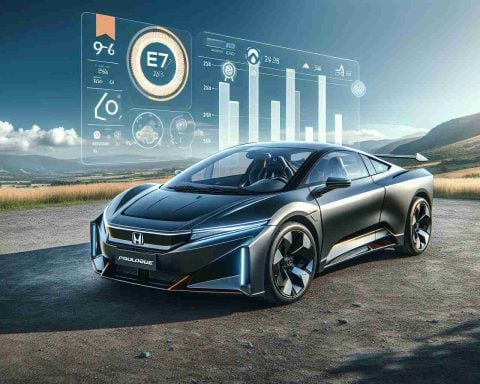- UBE Corporation is constructing a $491 million production facility in Jefferson Parish, Louisiana, to innovate the EV battery industry.
- The facility will be the first in the U.S. to produce dimethyl carbonate and ethyl methyl carbonate, essential for EV batteries and semiconductors.
- This initiative aims to reduce reliance on Chinese imports, strengthening the domestic supply chain and enhancing cost-effectiveness.
- Local environmental concerns present challenges, highlighting the need for balance between technological advancement and ecological responsibility.
- Under the supervision of industry leaders, UBE’s project may significantly contribute to the U.S.’s green future and technological independence.
A significant evolution is unfolding in Jefferson Parish, Louisiana, where the landscape will soon echo with the hum of what promises to be a groundbreaking production facility. The Japanese chemical giant, UBE Corporation, has broken ground on a $491 million plant, setting its sights on revolutionizing the electric vehicle (EV) battery industry by manufacturing key components right on U.S. soil. Nestled in the bustling hub of Cornerstone’s campus in Waggaman, this facility is poised to produce dimethyl carbonate and ethyl methyl carbonate—vital solvents for EV batteries and semiconductors. This initiative not only marks the first of its kind in the United States but also signals a transformative shift in the global supply chain.
Imagine a future where the road to a sustainable world is paved with shorter, efficient supply routes. As UBE sets this vision into motion, it aims to reduce America’s reliance on Chinese imports, fortifying a domestic supply chain that promises improved integration and cost-effectiveness.
Yet, the venture isn’t without its challenges. Local voices have echoed concerns about environmental impacts, casting a shadow over the otherwise sunny prospects of innovation. However, under the watchful eyes of Japanese Consul-General Shinji Watanabe and industry leaders, UBE’s project propels forward with determination.
This plant heralds a new era, where technological independence and environmental conservation must find a delicate balance. For a nation racing towards a green future, UBE’s groundbreaking move may just be the pivotal turn needed to drive innovation and secure sustainability, rooting a critical industry deeper into American soil.
Will UBE’s New Plant Spark an Electric Vehicle Revolution in the U.S.?
How-To Steps & Life Hacks
Optimizing Supply Chain Management in EV Manufacturing
1. Local Sourcing: Focus on establishing local partnerships to minimize logistical hurdles and import reliance, just as UBE has done by manufacturing key solvents in the U.S.
2. Technology Integration: Implement advanced manufacturing technologies to increase efficiency and reduce waste.
3. Regulatory Compliance: Stay informed about environmental regulations to ensure compliance and sustainability.
Real-World Use Cases
Applications of Dimethyl Carbonate and Ethyl Methyl Carbonate:
– Electric Vehicle Batteries: These solvents are crucial for electrolytes in lithium-ion batteries, increasing their efficiency and durability.
– Semiconductor Production: They are also used in the semiconductor industry, critical for producing electronics integral to modern technologies.
Market Forecasts & Industry Trends
According to a recent report by Market Research Future, the global electric vehicle market is projected to grow at a CAGR of over 22% from 2021 to 2030. The establishment of UBE’s plant in the U.S. indicates a trend towards building domestic supply chains for EV components, potentially accelerating this growth.
Reviews & Comparisons
Comparison with Chinese Imports:
– Cost Efficiency: Producing solvents locally could lead to cost savings in logistics and tariffs, providing competitive pricing against imports.
– Quality Control: Enhanced quality assurance through in-house production.
Controversies & Limitations
Environmental Concerns:
Local communities have raised worries about potential environmental impacts. It is crucial for UBE to engage with environmental consultants to address these concerns and implement robust sustainability practices.
Features, Specs & Pricing
While specific production capacities and pricing details have not been disclosed, UBE’s plant is a $491 million investment, indicating a significant production capability aimed at serving the EV and semiconductor markets.
Security & Sustainability
Sustainability Initiatives:
UBE has an opportunity to set benchmarks in eco-friendly manufacturing by adopting green technologies and ensuring minimal environmental footprint through sustainable practices.
Insights & Predictions
Impact on the U.S. EV Market:
Experts predict that UBE’s initiative could jumpstart a new wave of localized manufacturing, reducing supply chain vulnerabilities and fostering innovation within the U.S. EV market.
Tutorials & Compatibility
For companies looking to replicate UBE’s success:
– Adoption of Clean Technologies: Leverage eco-friendly manufacturing practices to balance innovation with environmental stewardship.
– Strategic Location: Select sites with existing industrial infrastructure for efficient integration.
Pros & Cons Overview
Pros:
– Reduced dependency on imports
– Potential cost savings and improved profitability
– Enhanced control over supply chain and quality
Cons:
– Potential environmental challenges
– Initial high investment costs
– Navigating local and federal regulations
Actionable Recommendations
1. Engage Stakeholders: Companies should actively communicate with local communities to address any environmental or operational concerns.
2. Focus on Innovation: Prioritize R&D to continually improve solvent efficiency and sustainability in battery applications.
3. Strategic Partnerships: Collaborate with other technology and EV industry leaders to foster innovation and integration.
4. Monitor Trends: Regularly analyze market and industry trends to remain competitive and responsive to changes.
5. Sustainability Measures: Implement advanced environmental protection measures to minimize the ecological footprint.
For more insights on technological advancements and sustainability in the chemical and EV industries, visit UBE Corporation.


















